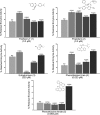Probing the peripheral site of human butyrylcholinesterase
- PMID: 22901043
- PMCID: PMC3438789
- DOI: 10.1021/bi300955k
Probing the peripheral site of human butyrylcholinesterase
Abstract
Acetylcholinesterase (AChE) and butyrylcholinesterase (BuChE) catalyze the hydrolysis of the neurotransmitter acetylcholine and, thereby, function as coregulators of cholinergic neurotransmission. For both enzymes, hydrolysis takes place near the bottom of a 20 Å deep active site gorge. A number of amino acid residues within the gorge have been identified as important in facilitating efficient catalysis and inhibitor binding. Of particular interest is the catalytic triad, consisting of serine, histidine, and glutamate residues, that mediates hydrolysis. Another site influencing the catalytic process is located above the catalytic triad toward the periphery of the active site gorge. This peripheral site (P-site) contains a number of aromatic amino acid residues as well as an aspartate residue that is able to interact with cationic substrates and guide them down the gorge to the catalytic triad. In human AChE, certain aryl residues in the vicinity of the anionic aspartate residue (D74), such as W286, have been implicated in ligand binding and have therefore been considered part of the P-site of the enzyme. The present study was undertaken to explore the P-site of human BuChE and determine whether, like AChE, aromatic side chains near the peripheral aspartate (D70) of this enzyme contribute to ligand binding. Results obtained, utilizing inhibitor competition studies and BuChE mutant species, indicate the participation of aryl residues (F329 and Y332) in the E-helix component of the BuChE active site gorge, along with the anionic aspartate residue (D70), in binding ligands to the P-site of the enzyme.
Figures





Similar articles
-
Aromatic amino-acid residues at the active and peripheral anionic sites control the binding of E2020 (Aricept) to cholinesterases.Eur J Biochem. 2003 Nov;270(22):4447-58. doi: 10.1046/j.1432-1033.2003.03837.x. Eur J Biochem. 2003. PMID: 14622273
-
Interaction between the peripheral site residues of human butyrylcholinesterase, D70 and Y332, in binding and hydrolysis of substrates.Biochim Biophys Acta. 1999 Aug 17;1433(1-2):281-93. doi: 10.1016/s0167-4838(99)00115-6. Biochim Biophys Acta. 1999. PMID: 10446378
-
Chimeric human cholinesterase. Identification of interaction sites responsible for recognition of acetyl- or butyrylcholinesterase-specific ligands.J Mol Biol. 1993 Nov 20;234(2):289-96. doi: 10.1006/jmbi.1993.1584. J Mol Biol. 1993. PMID: 8230213
-
Targeting acetylcholinesterase and butyrylcholinesterase in dementia.Int J Neuropsychopharmacol. 2006 Feb;9(1):101-24. doi: 10.1017/S1461145705005833. Epub 2005 Aug 5. Int J Neuropsychopharmacol. 2006. PMID: 16083515 Review.
-
[The fasciculin-acetylcholinesterase interaction].J Soc Biol. 1999;193(6):505-8. J Soc Biol. 1999. PMID: 10783708 Review. French.
Cited by
-
A hybrid of 1-deoxynojirimycin and benzotriazole induces preferential inhibition of butyrylcholinesterase (BuChE) over acetylcholinesterase (AChE).J Enzyme Inhib Med Chem. 2022 Dec;37(1):2395-2402. doi: 10.1080/14756366.2022.2117912. J Enzyme Inhib Med Chem. 2022. PMID: 36065944 Free PMC article.
-
New anthrarobin acyl derivatives as butyrylcholinesterase inhibitors: synthesis, in vitro and in silico studies.Heliyon. 2017 Jul 10;3(7):e00350. doi: 10.1016/j.heliyon.2017.e00350. eCollection 2017 Jul. Heliyon. 2017. PMID: 28725871 Free PMC article.
-
Comparison of the Binding of Reversible Inhibitors to Human Butyrylcholinesterase and Acetylcholinesterase: A Crystallographic, Kinetic and Calorimetric Study.Molecules. 2017 Nov 29;22(12):2098. doi: 10.3390/molecules22122098. Molecules. 2017. PMID: 29186056 Free PMC article.
-
Chemical Synthesis and Biological Activities of Amaryllidaceae Alkaloid Norbelladine Derivatives and Precursors.Molecules. 2022 Aug 31;27(17):5621. doi: 10.3390/molecules27175621. Molecules. 2022. PMID: 36080382 Free PMC article.
-
Exploiting butyrylcholinesterase inhibitors through a combined 3-D pharmacophore modeling, QSAR, molecular docking, and molecular dynamics investigation.RSC Adv. 2023 Mar 23;13(14):9513-9529. doi: 10.1039/d3ra00526g. eCollection 2023 Mar 20. RSC Adv. 2023. PMID: 36968055 Free PMC article.
References
-
- Silver A. (1974) The Biology of Cholinesterases, Elsevier, Amsterdam.
-
- Sussman J. L.; Harel M.; Frolow F.; Oefner C.; Goldman A.; Toker L.; Silman I. (1991) Atomic structure of acetylcholinesterase from Torpedo californica: a prototypic acetylcholine-binding protein. Science 253, 872–879. - PubMed
-
- Nicolet Y.; Lockridge O.; Masson P.; Fontecilla-Camps J. C.; Nachon F. (2003) Crystal structure of human butyrylcholinesterase and of its complexes with substrate and products. J. Biol. Chem. 278, 41141–41147. - PubMed
-
- Szegletes T.; Mallender W. D.; Rosenberry T. L. (1998) Nonequilibrium analysis alters the mechanistic interpretation of inhibition of acetylcholinesterase by peripheral site ligands. Biochemistry 37, 4206–4216. - PubMed
-
- Johnson J. L.; Cusack B.; Davies M. P.; Fauq A.; Rosenberry T. L. (2003) Unmasking tandem site interaction in human acetylcholinesterase. Substrate activation with a cationic acetanilide substrate. Biochemistry 42, 5438–5452. - PubMed
Publication types
MeSH terms
Substances
Grants and funding
LinkOut - more resources
Full Text Sources
Chemical Information

